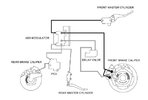16DCT
Member
From my understanding my 2016 NC700XD is equipped with linked rear-to-front brakes, meaning if I tap the rear brake it also puts a little bit of pressure on the front brake.
But what happens if I am using both front and rear brakes at the same time? Does the fact that I'm using the front brake manually override the linked brake feature, or does it still apply extra pressure to the front even though I'm already using the front brake lever?
But what happens if I am using both front and rear brakes at the same time? Does the fact that I'm using the front brake manually override the linked brake feature, or does it still apply extra pressure to the front even though I'm already using the front brake lever?






